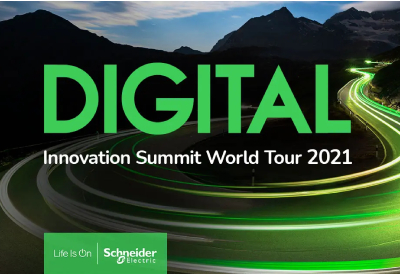Schneider Electric’s 2021 North American Innovation Summit: A Discussion with a Canadian company

November 15, 2021
By Elle Bremmer
On November 10, 2021, Schneider Electric held its virtual Innovation Summit North America, which was comprised of presentations from industry professionals regarding the summit’s central theme of digitization and a path towards sustainability. Topics included grids, data centres, and buildings of the future; sustainable supply chain operations; and sustainability, among others. Schneider Electric’s Canadian president, Adrian Thomas, hosted a session titled “Leadership and the Climate Challenge: The Path to Net-Zero” where Thomas, along with Frances Edmonds of Hewett Packard Canada and Toby Heaps of Corporate Knights discussed the changes that business is making to head towards net-zero emissions and how these changes impact businesses in the short- and medium-term.
In a meeting with Adrian Thomas, he discussed his vision of the path towards net-zero, for both Schneider Electric and beyond. Currently, Schneider Electric is striving for carbon neutrality by 2030. Schneider has global priorities and local commitments to reach this goal, all aligned with the 17 sustainability goals of the UN. Regarding climate change in Canada, he says that “with the size and population of Canada, we are actually one of the largest energy per capita consumers in the world, and that comes through the economy that we have. […] There is a misconception in Canada that our energy is completely green, when in reality it is very much not.” He cited a study from Environment and Climate Change Canada that Canada is warming twice as fast as the global average. He reiterated that now is the time for businesses, governments, and individuals to join forces boldly and aggressively to mitigate the most severe effects of climate change in the country, such as flooding. (See this 2019 map to find Quebec’s re-zoning of flood areas after the region faced severe flooding in 2017).
However, he mentions that Canadians have an excellent opportunity during the energy transition to deliver more efficient infrastructures. “I think Canada can also leverage the diversity of the population, its attractiveness to immigration to really bring innovation to the country to help us get through this energy transition.”
As for how the energy transition can be completed more smoothly and efficiently, Thomas offers two primary strategies to combat excess consumption of energy: a drive for decarbonization and leveraging technological advancements. He references other objectives from Annette Clayton, the keynote speaker of the summit. Overall, there are three steps organizations can take for a more sustainable future, Thomas says. “Reduce, Replace, Engage. Reduce per unit consumption per output, replace emitting sources of energy with non-emitting sources of energy, such as with renewables, and engage.” He continues, “large corporations, such as ourselves can really drive a difference in climate change. Engage with your employees and customers. Engage with supply chains. Supply chain emissions account for 11-11.5x more CO2 for a business than your direct consumption.”
As for how businesses can decarbonize their supply chain, Thomas says that “transparency is key.” He continues, “there is a saying in business that what gets measured gets done.” For businesses to create sustainability targets, they need to have a baseline understanding of where they are at and monitor and measure their carbon footprint.
Overall, Thomas seems to have an optimistic vision for the future but emphasizes the importance of actions taken. He also mentions how meeting smaller and more short-term goals are integral for hitting longer-term targets down the line. Regarding Schneider Electric and its role in the energy transition, he says: “We are known as an electric company, but sustainability is at the heart ofOverall, Thomas seems to have an optimistic vision for the future but emphasizes the importance of actions taken. He also mentions how meeting smaller and more short-term goals are integral for hitting longer-term targets down the line. Regarding Schneider Electric and its role in the energy transition, he says: “We are known as an electric company, but sustainability is at the heart ofwhat we do. One of the things that really gives me optimism is how digitizing and electrifying are really helping to solve this crisis. Providing infrastructure and software development is really important during this energy transition.”
Go HERE to learn more about the summit

















